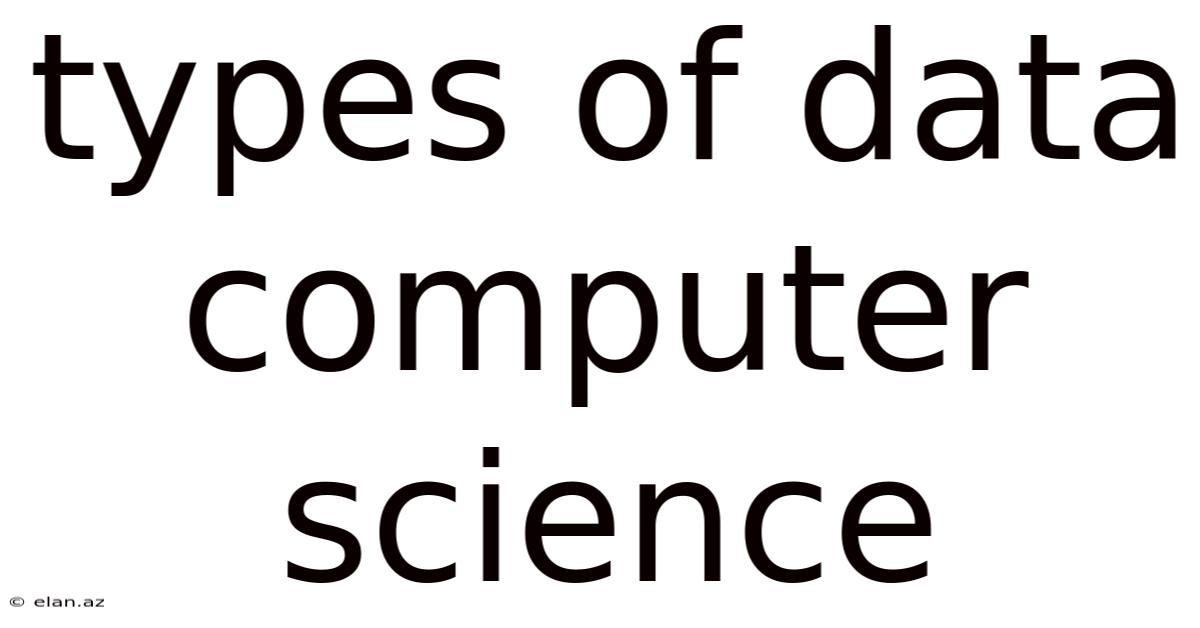Types Of Data Computer Science
elan
Sep 12, 2025 · 7 min read

Table of Contents
Decoding the Digital World: A Comprehensive Guide to Types of Data in Computer Science
Understanding data is fundamental to computer science. It's the lifeblood of every program, application, and system. From simple text messages to complex scientific simulations, data underpins everything. This article provides a comprehensive exploration of the various types of data used in computer science, examining their characteristics, applications, and interrelationships. We'll delve into the nuances of each category, clarifying the distinctions and highlighting their importance in the broader context of computing. This will serve as a robust foundation for anyone seeking a deeper understanding of data structures and management within the field.
Categorizing Data: A Hierarchical Approach
Data classification in computer science often employs a hierarchical structure. At the most fundamental level, we can broadly classify data into two major categories: structured and unstructured data. However, within each of these primary categories, numerous subtypes exist, each with its own unique properties and applications.
1. Structured Data
Structured data is characterized by its organized and well-defined format. It conforms to a predefined model or schema, making it easy to store, access, and process using relational databases and traditional data management systems. Think of neatly arranged rows and columns in a spreadsheet – that's the essence of structured data.
Key characteristics:
- Organized: Follows a specific format with clearly defined fields and data types.
- Predefined Schema: Data conforms to a pre-existing structure.
- Easily Searchable & Queryable: Efficiently processed using SQL and similar database languages.
- Consistent: Maintains uniformity in data representation.
Examples of Structured Data:
- Relational Databases (SQL Databases): These databases store data in tables with rows and columns. Examples include MySQL, PostgreSQL, Oracle, and Microsoft SQL Server. They are commonly used for managing structured data in businesses and organizations.
- CSV (Comma Separated Values) Files: Simple text files where data is separated by commas. These are frequently used for data exchange between different applications.
- XML (Extensible Markup Language): A markup language used to encode documents in a format that is both human-readable and machine-readable. XML is often used for data exchange and configuration files.
- JSON (JavaScript Object Notation): A lightweight data-interchange format that is easy for humans to read and write, and for machines to parse and generate. Widely used in web applications and APIs.
Different Data Types within Structured Data:
Within structured data, we encounter various data types that further define the nature of the information:
- Integer: Whole numbers (e.g., 10, -5, 0).
- Floating-Point: Numbers with decimal points (e.g., 3.14, -2.5).
- Character: Single letters or symbols (e.g., 'A', '!', '
Latest Posts
Latest Posts
-
Words That Start With Gar
Sep 12, 2025
-
1100 Sq Ft To M2
Sep 12, 2025
-
What Is 1000mm In Cm
Sep 12, 2025
-
3500 Square Feet To Meters
Sep 12, 2025
-
Integral Form Of Maxwell Equation
Sep 12, 2025
Related Post
Thank you for visiting our website which covers about Types Of Data Computer Science . We hope the information provided has been useful to you. Feel free to contact us if you have any questions or need further assistance. See you next time and don't miss to bookmark.